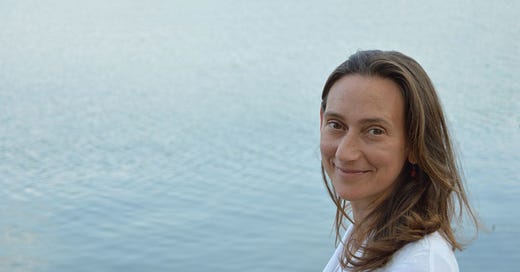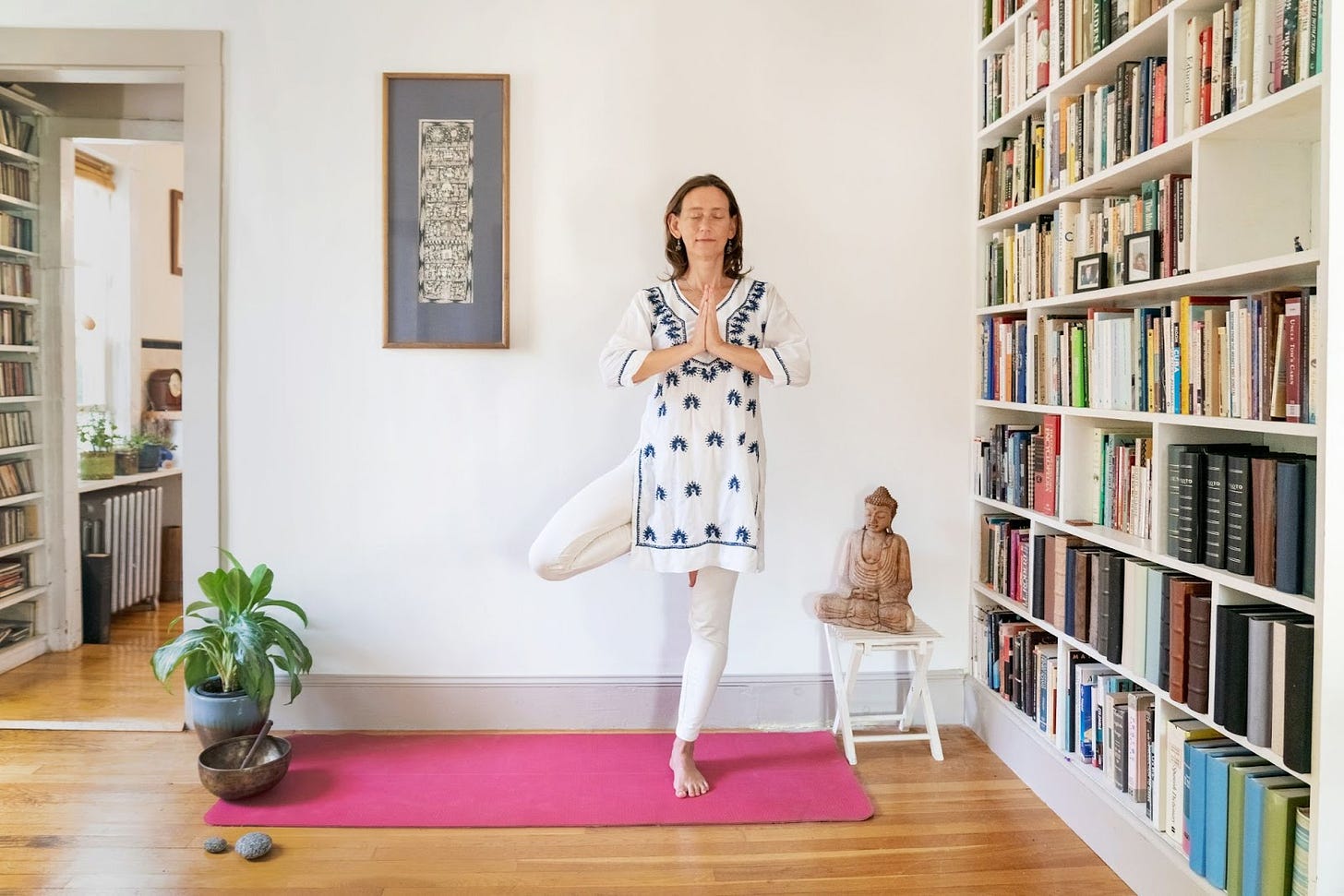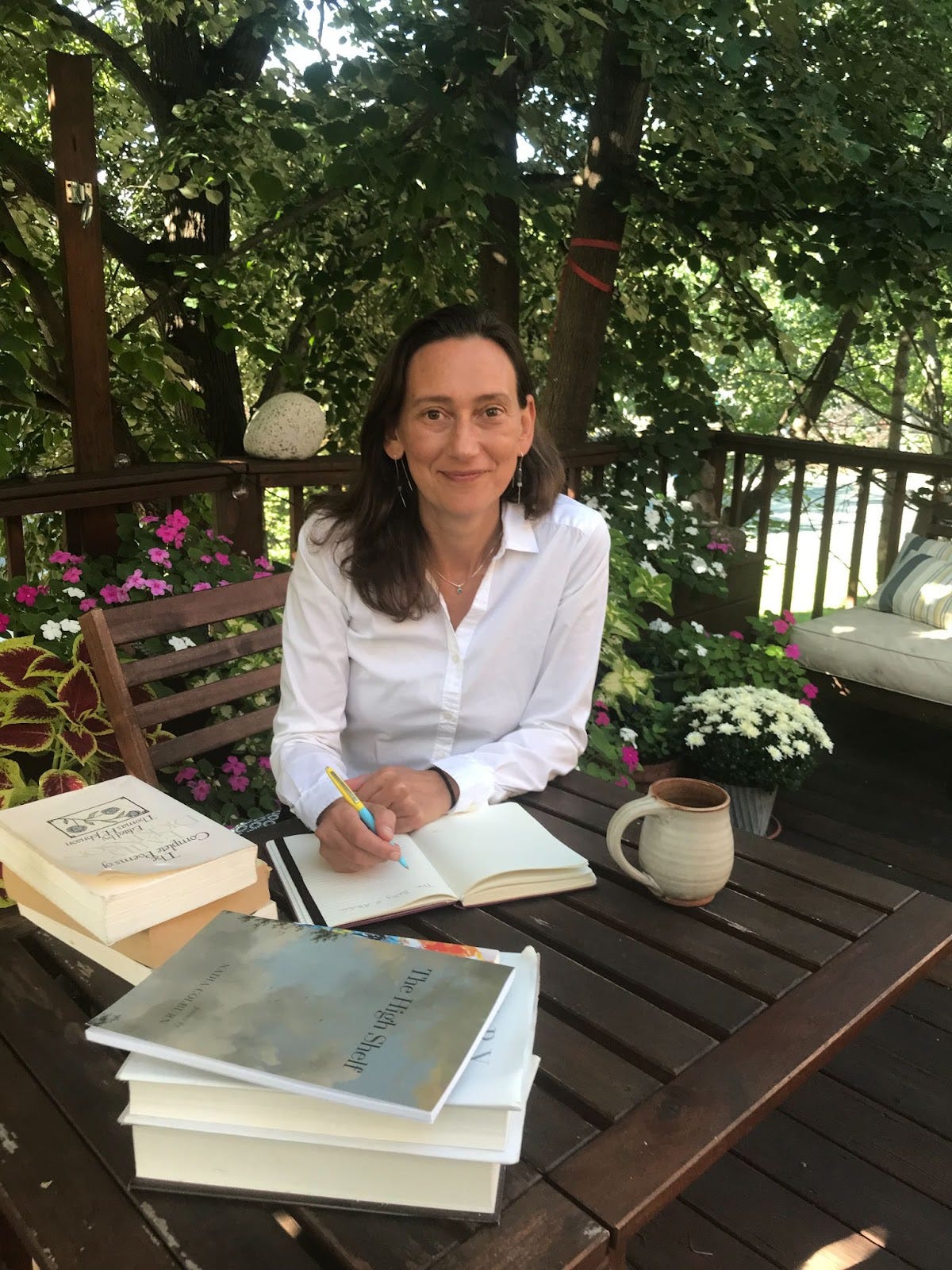"Keep coming back to your breath. Keep coming back to the page."
writer, poet, teacher and yogi Nadia Colburn on the power of mindfulness to transform our writing and creative practices, and to move toward connection and wonder ✨🙏🏼
This is a Beginner’s Mind interview, a series that explores the intersection of mindfulness and creative practice. Zen master Shunryū Suzuki Roshi said, “In the beginner’s mind, there are many possibilities; in the expert’s mind, there are few.” This series shines a light on the practices that sustain people in their daily lives and open the path to new possibilities. If you know (or are) a writer, creative person, mindfulness teacher or practitioner with practices you’d like to share, just reply to this newsletter to be in touch with me. Subscribe below to make sure you don’t miss any future interviews. ✨
I first discovered Nadia Colburn’s work last fall when I was trying to restart my writing practice after major burnout and a cross-country move. A friend texted me an interview with Nadia titled “Your Life Is Not a Task to Complete.” I felt indicted by this line and also intrigued. Had I just been mapping out the tasks I needed to complete in order to be a real writer again? Had I been beating myself up that I wasn’t further along? Yes and yes.
I sought out Nadia’s work and fell in love with her recent poetry collection, I Say The Sky. These days, I carry lines from her poems with me, including: “You, who were so quiet, didn’t you know / there was a symphony inside you?”
I also found Nadia’s teachings online and have been deeply inspired by how she connects her writing and mindfulness practices. As readers of this newsletter, I trust you will find her wisdom as resonant as I do. ✨🙏🏼
What are your writing/creative practices? Do you have any rituals or habits that help you?
I usually meditate and I connect mind and body before I write, but even if I don’t do these practices immediately before I write, I consciously bring my writing to that part of me that is mindful, embodied, aware, at once here now and also larger than some small view of the self.
The practices that help me get into that state of inspiration are: meditating, moving my body, most often in yoga or walking, reading books that I love, being in the natural world. I need to give time and space to what isn’t normally heard, seen.
What are your mindfulness practices?
I think it was therapy that first brought me to mindfulness–I learned to witness myself, to sit with things and come out of judgment, redaction–to be with. Then, I started to practice mindfulness through my yoga practices–almost thirty years ago now.
I used to struggle with silent meditation. I’d feel almost claustrophobic when I stopped and sat with myself. Sitting with myself brought up old trauma–though I didn’t have a vocabulary to understand what was happening at the time.
But I learned to be present with myself through movement, and then later through chanting, and through that I learned to listen to my body and gradually come into greater stillness.
I became a serious student of Thich Nhat Hanh and also practiced vipassana meditation.
Exactly because meditation was hard for me, it was all the more transformative. Eventually, meditation reset my nervous system. It helped me with almost every area of my life, including being a writer.
For me, mindfulness is being aware of what is, of expanding my perspective from the little window through which I normally perceive the world as being full of static entities and stories to one that is dynamic, interconnected.
I try to notice, witness, from a place of awareness, beyond the small self. From that place, I see greater connection, greater aliveness and wonder.
It’s hard for me to respond to these questions and not give a nod to what is happening in our political/ social/ environmental sphere here in the US.
Mindfulness is also for me about coming back to that balance between what I do and don’t have agency over: about being present so that I can take a step from that place of connectedness.
This is one big, strange, often scary, very beautiful world we are in, and it takes these grounding practices to be able to be with it all, to both sit and take action.
Do you have a mantra or motto related to your creative/mindfulness practices/life? What piece of wisdom do you have on a post-it note to help you remember it?
Okay, well, to be honest, at certain points I have literally posted up for myself on a post it note so that I see it in the early morning: “I am a spiritual person.” That sounds so silly, but it has been important for me to remember this. Sometimes the world can feel overwhelming—the suffering, the injustice, the sense of confusion about how and why things are the way they are.
And remembering that I am larger than just this small self, that we are all larger than this small self, that we are even larger than this historic moment helps.
For me to be mindful, to be spiritual is to expand my perspective, but paradoxically to expand through being present, by being with.
I remember one of the first dharma talks I went to was about the diamond that cuts through illusion, and my teacher was talking about how by looking at a solid object, buddha was able to come to the insight that modern physics came to: that the solid thing is composed of entities that themselves are not solid or static.
Blake said something similar; to see the world through a grain of sand.
For me mindfulness and spirituality are connected to the earth and the body.
I also believe that our personal stories have meaning through their unique personal details; it is through our uniqueness that we connect most with others and through our getting clear on our stories and selves that we are able to manifest the change we want to see in the world.
So I suppose my advice would be to stay with the body, stay with the self–make that self particular, but at the same time, make that self connected to all things, and go beyond ego.
The things that knock us off—the shadow side of our lives—are also opportunities for growth, understanding, compassion and the impetus to our greatest and deepest purpose in the world.
And keep coming back to your breath. Keep coming back to the page.
Do you see your creative and mindfulness practices as connected? In what ways?
YES!!! Absolutely. At this point, I can’t unbraid the practices. I see the world through my mindfulness and creative practices and each informs the other.
Being mindful is exactly what we are asked to do as writers, to be with, to notice, to pay attention and make connections, so I don’t know how to disentangle the two.
And all of my courses include mindfulness and writing. My upcoming course Align Your Story includes reading, writing, yoga and meditation because to write well, we need to learn how to listen to our bodies; we need to learn how to stop our constant, programmed chatter, get still, and witness what is really there.
So many of us are taught to write from the head alone. We’re given these techniques to put a sentence together. But we aren’t given techniques to really witness what is there, in our own bodies, our own stories, our own hearts.
And so our literature often just repeats old stories.
As creative people, it’s our job to pay attention to what is under the surface. It’s our job to tell different stories, create new patterns.
And to do that we need to be able to tap into new forms of attention, need to learn to listen into the physical world and the silences–even with all the world’s confusing noise. Mindfulness helps us do that.
Mindfulness is a practice of peace, of compassion–we certainly need more of that. And we need literature that reflects that.
I have a free Masterclass teaching the backbone of that integrated practice in my longer Align Your Story Class. This free class is about how to bring together mindfulness, embodied practices and writing together: I’d love to see you there: https://nadiacolburn.com/four-steps-to-revitalize-your-writing-and-reclaim-your-story-masterclass/
How do you see your creative/mindfulness practices connected to/shaped by other practices or work in your life?
I’ve always been interested in activism. I believe that it’s important to use our voices in a wide capacity–in our personal lives, in our art on the page, in our political systems–it’s not one or the other.
I want my art itself to be a message of truth telling and of a path towards a more heart centered world. But I also want to use my voice to call politicians, to write more political op-eds, to go out and protest.
And to me, having this versatility, speaking in different ways and in different forums, itself is a form of mindfulness.
Buddha taught differently to different students. We speak differently depending on our audience, and we use our voice mindfulness to reach people in the ways they can be heard.
Thich Nhat Hanh’s Fourth Mindfulness training is on deep listening and right speech: “Aware of the suffering caused by unmindful speech and the inability to listen to others, I am committed to cultivating loving speech and deep listening in order to bring joy and happiness to others and relieve others of their suffering. Knowing that words can create happiness or suffering, I am determined to speak truthfully, with words that inspire self-confidence, joy, and hope. I will not spread news that I do not know to be certain and will not criticize or condemn things of which I am not sure.”
Sometimes it can be hard to both speak truthfully and inspire joy and hope, but I think that is a line. I think that not speaking truthfully, not naming the difficult things that are happening, itself causes mistrust and division.
I believe that what we say is truly one of the very most powerful things that we have as humans–in some ways even more powerful than guns.
The framers of the constitution understood this. The first amendment is freedom of speech.
And the first thing that authoritarians want to do is curtail the freedom of speech, to control the media, control the stories. We are seeing that right now.
And so it’s all the more important that we cultivate our own mindful use of language, that we do not shy away from speaking mindfully and using our voices–that’s a very powerful thing.
Are there any books / writers / teachers / approaches that have been transformative for you that you would recommend to readers?
Thich Nhat Hanh and his teachings on engaged buddhism, practicing peace, and interbeing have been deeply transformative (see these two essays I’ve written about how important his teachings have been for me): “On My Teacher, Thich Nhat Hanh” and “Journey as a Writer.”
Paul Hawken and his books Drawdown and Regeneration inspire me with the abundance of positive ways the earth and her systems support us and one another and the abundance of ways that we can support her. (Here is a video interview I did with Paul).
Here is a list of some of the female memoir writers who particularly inspire me.
What advice would you give someone who is trying to start or restart a creative or mindfulness practice?
Start slow. Be gentle. Schedule time on your calendar. Even if it’s just 15 minutes. Set aside time—often early in the day works well, but if that is impossible, find another time. Meditate and then write–connect the two positive habits.
Treat the time for that practice like you would any other meeting or appointment. And find some inspiration! You don’t have to sit in front of the blank page alone in a room. Open up a book, go for a walk, etc.
ALSO: Sign up for my free 5-day challenge! It’s a wonderful way to start or restart practice…Many people find that what at first starts as something that they intend to do becomes something they are looking forward to doing. https://nadiacolburn.com/free-mindful-writing-challenge/

A Poem & Prompt from Nadia
I want to share a poem from my book I Say the Sky. I suggest meditating and then reading this poem:
Outside the Sparrows are Awake
and all the complications in my heart:
I, who did not know how to love
my own body, who mistook
the world for a task. Listen:
one voice and then another
amid the rustling of the leaves.
And then here is a prompt: what is something that has taught you to love part of yourself?
You can interpret the word “love” however you want. Be in dialogue with whatever that teacher is. Here are a few words you might want to incorporate into your piece: complication, heart, voice, leaves.
If you do this prompt after meditating, you might find that it’s easier to come out of your head and drop into your body and heart as you write. Allow your pen to move without needing to “control” it or write something good or even coherent. You might surprise yourself. See where it takes you.
Nadia Colburn is the author of the poetry books I Say the Sky (winner of the 2024 American Bookfest Book Awards for Best Poetry Book: General and Best Poetry Book: Nature) and The High Shelf. Her poetry and prose have appeared in numerous publications, including The New Yorker, American Poetry Review, The Kenyon Review, and The Yale Review. She holds a Ph.D. in English from Columbia University; she is a serious student of Thich Nhat Hanh, a certified kundalini yoga teacher, a creativity coach and writing teacher, and the founder of Align Your Story Writing School, which brings traditional literary and creative writing studies together with mindfulness, embodied practices, and social and environmental engagement and has a community of over 40,000 writers. Find her at nadiacolburn.com, where she offers meditations and free resources for writers. You can also follow Nadia on Instagram at @nadia.colburn and on Facebook at @alignyourstory (business page) and @nadia.h.colburn (personal page).
More from Nadia ✨🙏🏼
Try Nadia’s Free 5-Day Meditation & Writing Challenge HERE!
Order Nadia’s book, I Say The Sky here! And if you buy the book, sign up for the free companion 7-day meditation and writing challenge as well: https://nadiacolburn.com/7-day-new-year-practice/
Learn more about Nadia’s online creative writing school, Align Your Story Writing School.
Nadia’s free Masterclass about how to bring together mindfulness, embodied practices and writing. A perfect fit for our readers here at Be Where You Are!
What You May have Missed on Be Where You Are
The next Ass in Chair Collective this Mon, May 5th is for paid subscribers. You can find all the details for spring in the post below.👇🏼
Before you go, will you take one moment to hit the LIKE button or leave a quick comment? This one simple action is incredibly effective at helping to spread the word about Nadia’s work & what’s happening here at Be Where You Are 🌱 Be Where You Are is 100% reader-supported. You can support this work by becoming a paid subscriber for 5$ a month or make a one-time donation here if you value this work but can’t subscribe. Or, just send it to a friend! 🙏🏼🩵
Be Where You Are is a newsletter about how to use writing and mindfulness to live more fully where you are. To reply to this newsletter, just hit reply. I’d love to hear from you! You can also find me on Instagram/Facebook/Bluesky or find more info at my website.









